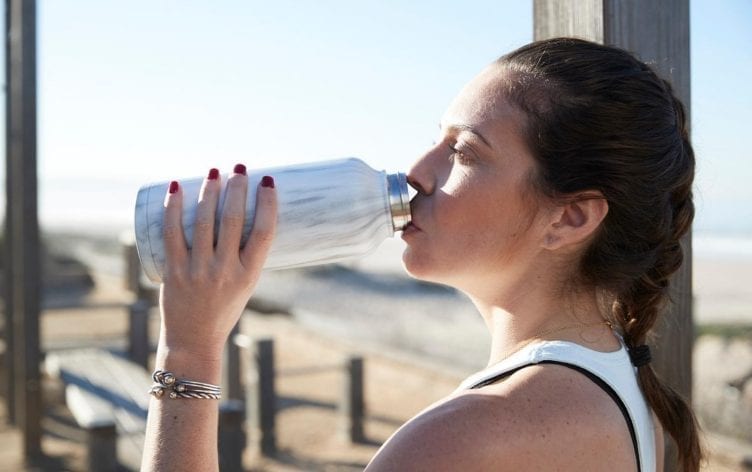
Many athletes reach for drink mixes to fuel daily workouts or simply add flavor to water. While it seems like a simple and easy option to consume electrolytes, calories and water all in one, it is actually much more complicated.
The decision to load bottles with a sports drink mix or just drink plain water is more complicated than grabbing a gel or bar to fuel your body and should be given careful consideration to determine what it is right for your training needs.
If you’re new to using mix, dilute it with water. This allows your gut to get used to drinking carbohydrates and sodium slowly with less chance of gastric distress. Solutions with 6–8% carbohydrate are best tolerated. If you’re a cyclist, bringing bottles one ride and using one for a sports drink and one for water is a best practice. And, if you’re training for longer than 90 minutes, use a mix that supplies half of your needs and get the other half from food.
Finally, it’s important to know your sweat rate, sodium needs and calorie requirements for each individual training session — based on duration, temperature, intensity, fueling ease — to make the best fueling and hydration decisions.
WHEN TO USE A SPORT DRINK
Adding mix to your bottles, or using a pre-made sports drink, is a good idea in several situations. First — and most obvious — it’s convenient. It creates an ‘all-in-one’ strategy, where you can hydrate, get calories and replenish electrolytes in one easy-to-consume, easy-to-carry form. Putting mix in your bottle is also a great reminder to drink, as it improves the taste, which can be helpful for those who otherwise struggle to sip enough water while training. This is great for those who find it difficult to carry extra fuel on long workouts.
Second, for short training, where consuming extra calories isn’t necessary, a few sips of a sports drink can be just enough to boost your energy. Carbohydrate rinsing — swishing the mouth with a high carbohydrate drink — can give you just the edge you need. Low carbohydrate mixes that rely on electrolytes can help replace sweat and nutrients lost without adding unnecessary carbohydrates.
Third, athletes who have sensitive stomachs or those who are new to training with calories might find it easier to obtain energy needs from drink rather than having to digest more solid food.
Finally, loading bottles is also beneficial for intense, technical training or racing where grabbing for, unwrapping and chewing would be difficult and even dangerous. Being able to sip from a bottle or hydration pack with a straw requires less effort and takes less focus away from the athletic task at hand.
WHAT SPORTS DRINK TO USE
Attempting to meet energy and hydration needs through a drink gets more complicated as hydration and energy needs vary independently of each other. For example, in the summer, caloric intake may generally remain stable; 45–60 grams of carbohydrates per hour for most training sessions, while hydration needs increase relative to temperature and humidity. Relying on liquid fuel to get hydration and calories might leave you over fueled and under hydrated or under fueled and over hydrated — it is difficult to properly balance.
Sipping a low-to-moderate carbohydrate mix can be a good way to disperse energy intake between gels or solid food intake. This might help keep energy levels consistent and high throughout the entire effort. It is crucial to note this only works if you use drink mix as a supplement to other sources of nutrition and energy; relying on drink mix alone might not meet total energy needs. Taking a sip might only give you 5–10 calories at a time, which won’t help you surge ahead or prevent a bonk. You wouldn’t just lick a sport chew and act like that provided enough fuel, yet that’s basically what you get from drinking calories one sip at a time.
It’s important to select the right sports drink for you. Beyond calories, carbohydrates and hydration, a sports drink or mix contains electrolytes. These minerals, primarily the sodium lost in sweat, are essential for athletes. Losing too much sodium during a session can cause puffiness, gastric distress, cramps and confusion. Sodium needs range greatly from athlete to athlete, many need 4–6 grams/day while the general public requires 1.5–2g/d. And sodium content of mixes varies wildly — some contain barely any, while others have amounts needed by heavy, salty sweaters. Remember mixes are not all created equally; they vary greatly from one brand to another. Make sure you know what your mix is providing and if it is appropriate for what you need during that session.
THE BOTTOM LINE
If this all sounds like a lot to consider when all you wanted was to shake up a bottle and head to the gym, it doesn’t have to be so complicated.
For workouts under an hour, aim for just water or a light mix that has more electrolytes and less carbohydrates. For training greater than 2 hours, use a moderate mix in combination with other fueling sources. Ultimately, strive to know your needs, sweat rate, sodium loss and calorie needs for each training session, and match those needs with an appropriate fueling and hydration strategy. Having multiple drink mixes with varying amounts of calories and sodium to pick from is your best option.



